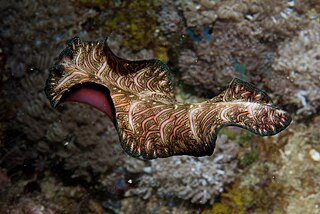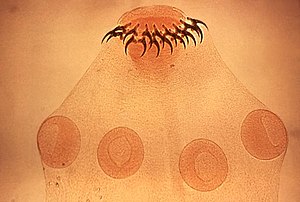
An octopus is a soft-bodied, eight-limbed mollusc of the order Octopoda. The order consists of some 300 species and is grouped within the class Cephalopoda with squids, cuttlefish, and nautiloids. Like other cephalopods, an octopus is bilaterally symmetric with two eyes and a beaked mouth at the center point of the eight limbs. The soft body can radically alter its shape, enabling octopuses to squeeze through small gaps. They trail their eight appendages behind them as they swim. The siphon is used both for respiration and for locomotion, by expelling a jet of water. Octopuses have a complex nervous system and excellent sight, and are among the most intelligent and behaviourally diverse of all invertebrates.

The flatworms, flat worms, Platyhelminthes, or platyhelminths are a phylum of relatively simple bilaterian, unsegmented, soft-bodied invertebrates. Unlike other bilaterians, they are acoelomates, and have no specialised circulatory and respiratory organs, which restricts them to having flattened shapes that allow oxygen and nutrients to pass through their bodies by diffusion. The digestive cavity has only one opening for both ingestion and egestion ; as a result, the food cannot be processed continuously.

A squid is a mollusc with an elongated soft body, large eyes, eight arms, and two tentacles in the superorder Decapodiformes, though many other molluscs within the broader Neocoleoidea are also called squid despite not strictly fitting these criteria. Like all other cephalopods, squid have a distinct head, bilateral symmetry, and a mantle. They are mainly soft-bodied, like octopuses, but have a small internal skeleton in the form of a rod-like gladius or pen, made of chitin.

Trematoda is a class of flatworms known as flukes or trematodes. They are obligate internal parasites with a complex life cycle requiring at least two hosts. The intermediate host, in which asexual reproduction occurs, is usually a snail. The definitive host, where the flukes sexually reproduce, is a vertebrate. Infection by trematodes can cause disease in all five traditional vertebrate classes: mammals, birds, amphibians, reptiles, and fish.

Digenea is a class of trematodes in the Platyhelminthes phylum, consisting of parasitic flatworms with a syncytial tegument and, usually, two suckers, one ventral and one oral. Adults commonly live within the digestive tract, but occur throughout the organ systems of all classes of vertebrates. Once thought to be related to the Monogenea, it is now recognised that they are closest to the Aspidogastrea and that the Monogenea are more closely allied with the Cestoda. Around 6,000 species have been described to date.

Monogeneans, members of the class Monogenea, are a group of ectoparasitic flatworms commonly found on the skin, gills, or fins of fish. They have a direct lifecycle and do not require an intermediate host. Adults are hermaphrodites, meaning they have both male and female reproductive structures.

The Aspidogastrea is a small group of flukes comprising about 80 species. It is a subclass of the trematoda, and sister group to the Digenea. Species range in length from approximately one millimeter to several centimeters. They are parasites of freshwater and marine molluscs and vertebrates. Maturation may occur in the mollusc or vertebrate host. None of the species has any economic importance, but the group is of very great interest to biologists because it has several characters which appear to be archaic.

All cephalopods possess flexible limbs extending from their heads and surrounding their beaks. These appendages, which function as muscular hydrostats, have been variously termed arms, legs or tentacles.
Entobdella soleae is a monogenean (Platyhelminth) skin parasite of the common sole, Solea solea, an important food fish. They are approximately 2 to 6 mm in length. It is flat, translucent, and has a large, disc-shaped haptor, a posterior organ used for semi-permanent attachment to the host. Typically, 2-6 parasites are found on wild sole, but in intensive fish farms this can rise to 200-300 parasites per fish, causing skin inflammation and sometimes death of the sole. E. soleae can live up to 120 days in seawater.

Leeches are segmented parasitic or predatory worms that comprise the subclass Hirudinea within the phylum Annelida. They are closely related to the oligochaetes, which include the earthworm, and like them have soft, muscular segmented bodies that can lengthen and contract. Both groups are hermaphrodites and have a clitellum, but leeches typically differ from the oligochaetes in having suckers at both ends and in having ring markings that do not correspond with their internal segmentation. The body is muscular and relatively solid, and the coelom, the spacious body cavity found in other annelids, is reduced to small channels.

Worms are many different distantly related bilateral animals that typically have a long cylindrical tube-like body, no limbs, and no eyes.

Cestoda is a class of parasitic worms in the flatworm phylum (Platyhelminthes). Most of the species—and the best-known—are those in the subclass Eucestoda; they are ribbon-like worms as adults, known as tapeworms. Their bodies consist of many similar units known as proglottids—essentially packages of eggs which are regularly shed into the environment to infect other organisms. Species of the other subclass, Cestodaria, are mainly fish infecting parasites.
Diphyllobothrium mansonoides is a species of tapeworm (cestodes) that is endemic to North America. Infection with D. mansonoides in humans can result in sparganosis. Justus F. Mueller first reported this organism in 1935. D. mansonoides is similar to D. latum and Spirometra erinacei. When the organism was discovered, scientist did not know if D. mansonoides and S. erinacei were separate species. PCR analysis of the two worms has shown the two to be separate but closely related organisms.

The pelvis is the lower part of the trunk, between the abdomen and the thighs, together with its embedded skeleton.
Homalometron pallidum is a species of marine trematodes in the family Apocreadiidae. It is an endoparasite of the mummichog, Fundulus heteroclitus, a small fish found in brackish water along the east coast of the United States and Canada. It has a complex life cycle and lives inside several different host species at different stages.

Fins are moving appendages protruding from the body of fish that interact with water to generate thrust and help the fish swim. Apart from the tail or caudal fin, fish fins have no direct connection with the spine and are supported only by muscles.
Acetabulum in invertebrate zoology is a saucer-shaped organ of attachment in some annelid worms and flatworms. It is a specialised sucker for parasitic adaptation in trematodes by which the worms are able to attach on the host. In annelids, it is basically a locomotory organ for attaching to a substratum. The name also applies to the suction appendage on the arms of cephalopod molluscs such as squid, octopus, cuttlefish, Nautilus, etc.

The haptor is the attachment organ of the monogeneans, a group of parasitic Platyhelminthes. The haptor is sometimes called opisthaptor to emphasize that it is located in the posterior part of the body, and to differentiate it from the prohaptor, a structure including glands located at the anterior part of the body. According to Yamaguti (1963), the chief adhesive organ of the monogeneans, the haptor, is posterior, more or less discoid, muscular, may be divided into alveoli or loculi, is usually provided with anchors, has nearly always marginal larval hooklets, or is in a reduced form with anchors. The haptor may consist of symmetrical or asymmetrical, sessile or pedunculate, muscular suckers or clamps with or without supporting sclerites; accessory adhesive organs may be present in form of armed plaques, lappets or appendices.

Pelvic fins or ventral fins are paired fins located on the ventral (belly) surface of fish, and are the lower of the only two sets of paired fins. The pelvic fins are homologous to the hindlimbs of tetrapods, which evolved from lobe-finned fish during the Middle Devonian.
Glaridacris catostomi is a flatworm of the family Caryophyllaeidae. It is commonly found in freshwater environments of North America and is a known internal parasite of fishes of the family Catostomidae.



















